In the mid-12th century, on a coastal plain just inland from the North Sea, noblemen would come to hunt. Located in a woodland area on the plain called Haghe (hedge), the hunting lodge became known as Gravenshage (counts' private enclosure), shortened in Dutch to Den Haag (The Hague).
Today, Den Haag is Netherlands' third largest city after Amsterdam and Rotterdam, and is the capital of the province of South Holland and the administrative capital of the country, though Amsterdam is the official capital. It is the seat of government of the Netherlands, home to the Supreme Court, the International Court of Justice, the International Criminal Court, the working palace of the Dutch royal family and the global HQ of Shell.
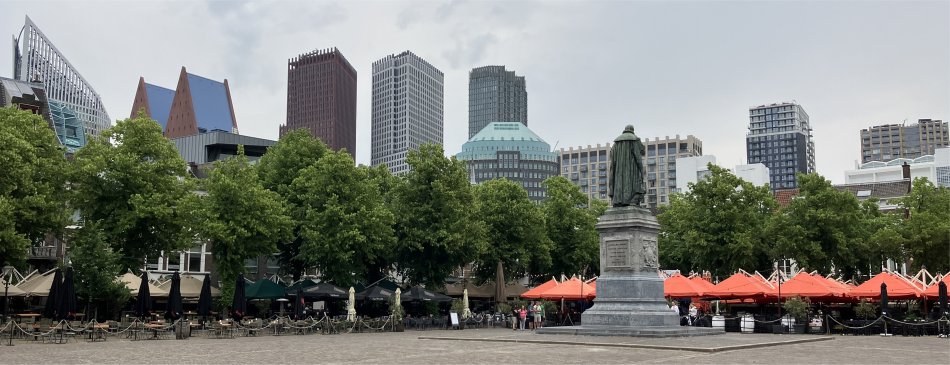 't Plein in Den Haag |
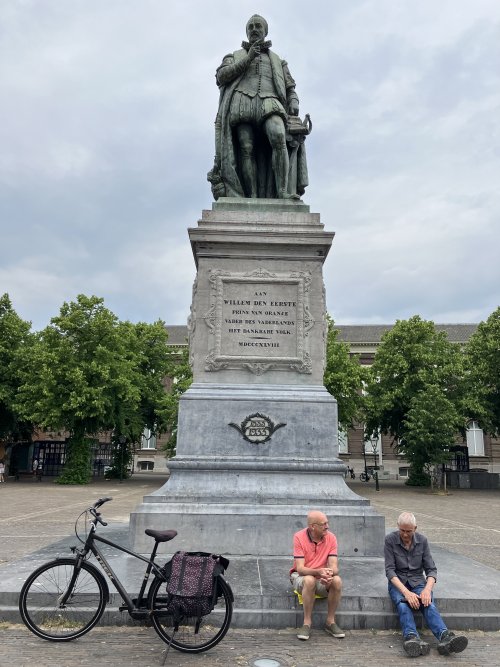 To Willem I, Prince of Orange, Father of the Fatherland, the Grateful People |
A commercial district grew up around the Binnenhof in the 13th and 14th centuries, and it survives on shopping streets such as Venestraat, Spuistraat, Gravenstraat, and Hoogstraat. In the 16th century Holland (province) became the chief centre of Dutch resistance to Spanish Habsburg rule, and in 1559 William I, stadholder of the Netherlands, made Den Haag his capital. About 1585 the States-General, along with other bodies of the Dutch Republic's central government, established themselves in the Binnenhof. William's son, Prince Maurice of Orange, soon took up residence in Den Haag, and at his initiative in 1616 a web of canals was constructed around the city that continued to define its borders to the mid-19th century. Around this time, imposing aristocratic mansions were constructed on the eastern side of the Binnenhof. To the southeast grew the Spui (craftsmen's district) and small inner harbours, and to the west the Prinsegracht (home to the wealthy middle class), which was connected to the horticultural area of the Westland by the Loosduinse canal.
The Binnenhof is surrounded by buildings dating from the 15th to the 18th century. Among these historical landmarks are the Great Church of St. Jacob (Jacobskerk; 1399), which has a hexagonal tower and a richly decorated late Gothic choir, as well as the largest carillon in the Netherlands; the Protestant New Church (1654); the royal palace on the Noordeinde (16th century); the royal palace known as the House in the Wood (Huis ten Bosch; 1645-47); and the old Renaissance-style town hall (1564), which was subsequently enlarged several times.
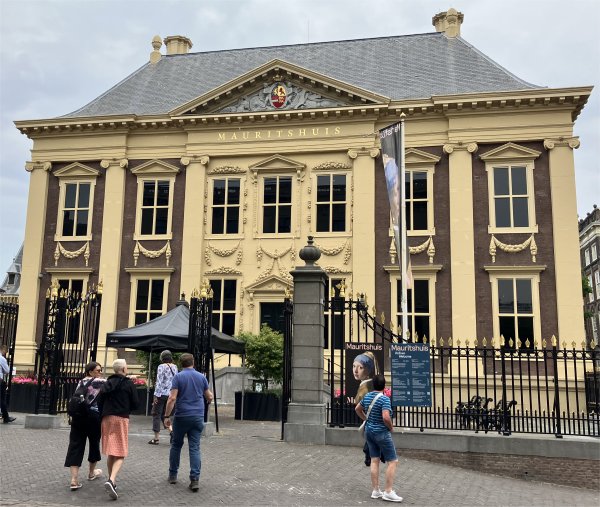 Mauritshuis |
The Binnenhof would normally be open to the public, but sadly it has been closed to the public since 2020. Renovation was necessary to improve fire safety and repair major defects, such as leaking roofs and rotting wood. A number of areas including technical installations, ITC and security were being investigated, in addition to improvements to the entrances, kitchens and restaurants.
It was then estimated it would take 5.5 years to complete at a maximum cost of 475 million Euros. The renovation of the parliamentary complex will, at the time of writing, take at least two years longer than previously planned because of extra security measures and the unresolved issue of regulating nitrogen compound emissions, with estimates for the total cost of the renovations at 750 million Euros.
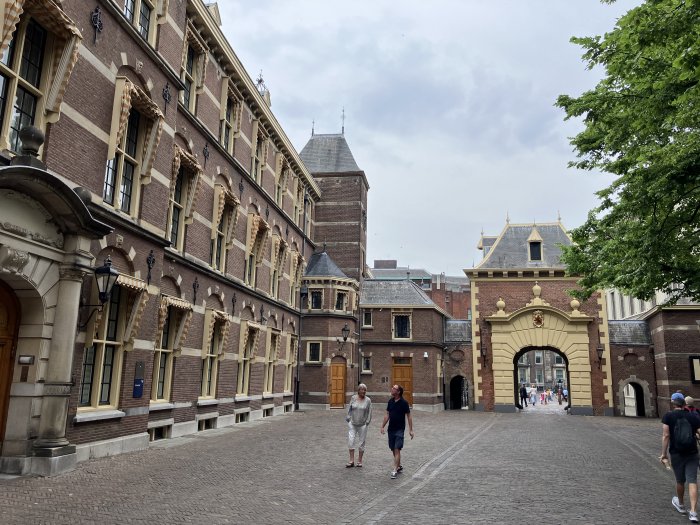 First Half of the Binnenhof Courtyard |
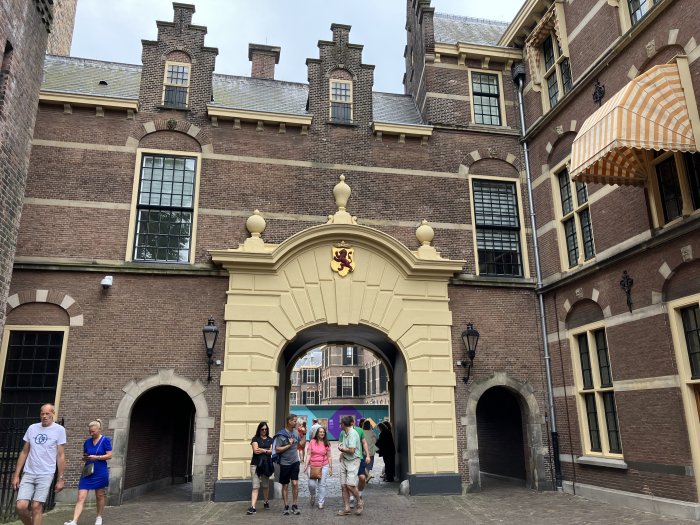 First Half of the Binnenhof Courtyard |
Just past the Mauritshuis was an arched entrance, the famous entry gate into the historical Binnenhof (Inner Court) in the heart of the Dutch democracy. This is the place where the most important events in the nation's history took place. It is also where the future is created. The Inner Court in The Hague is studded with monumental old buildings testifying of eight centuries of governing in the Low Countries, but it also has several ample open spaces, all freely open to the public.
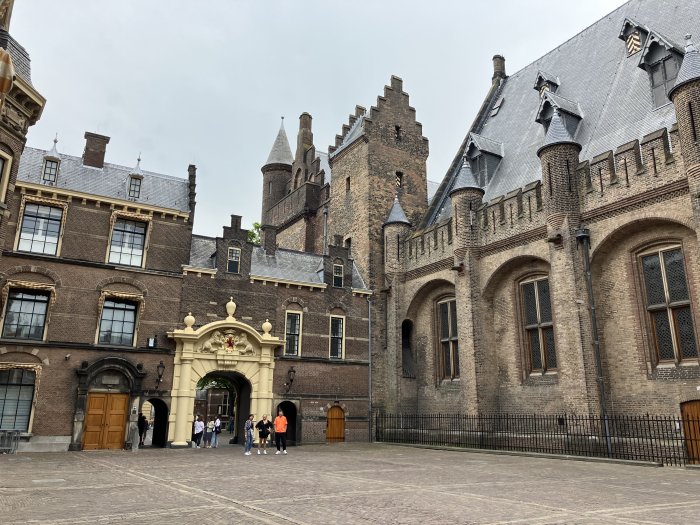 Second Half of the Binnenhof Courtyard |
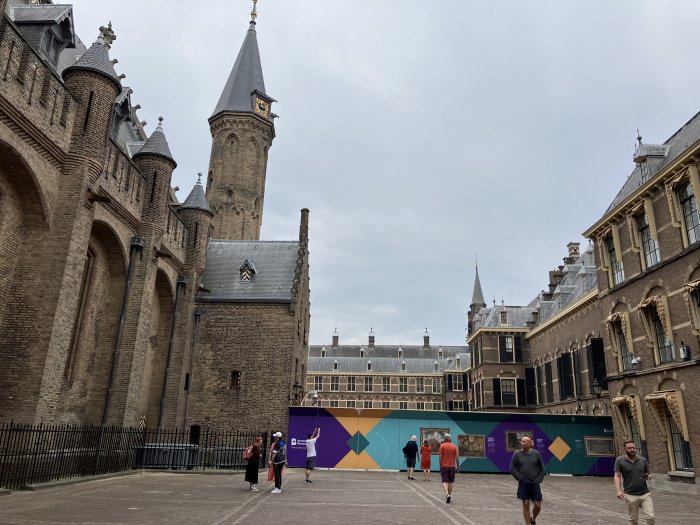 Tall, Impressive Ridderzaal on the Left |
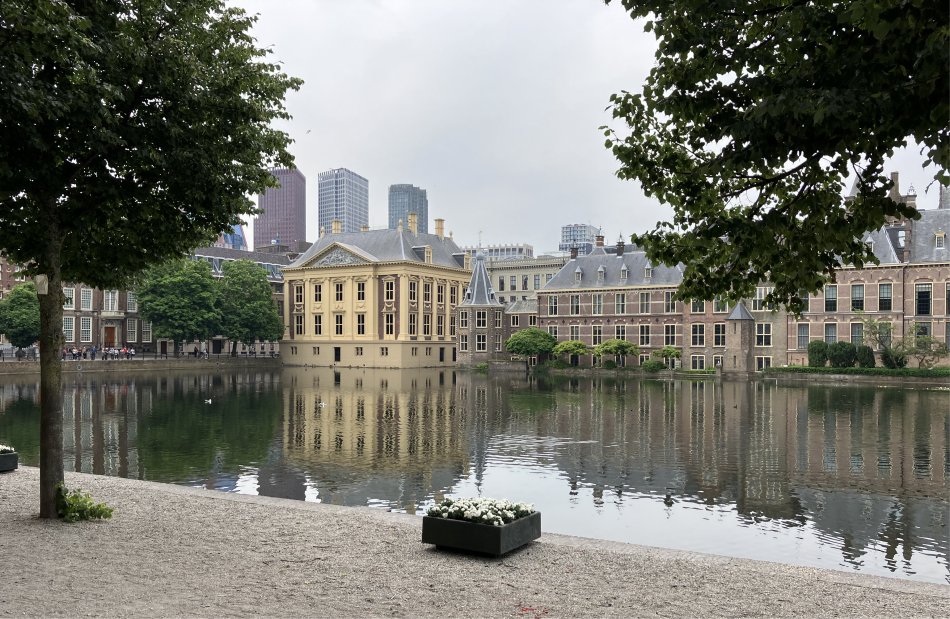 Hofvijver from the Lange Vijverberg - Note the Small Octogonal Torentje Tower to the Right of the Mauritshuis |
Having soaked up that wonderful historic atmosphere, we left the courtyard, skirted around the outside of the Mauritshuis, and arrived at the Hofvijver (Court Pond), the artificial lake beside the Binnenhof. The Hofvijver was first dug out by the counts of Holland in the late 13th century. Originally a natural body of water among the sand dunes, the Court Pond was extended over the years. The excavated sand was piled up on the north side of the lake to form the elevated area known as the Lange Vijverberg, now occupied by a graciously curving line of mostly 18th century mansions. The 17th century buildings along the short side of the lake, the Korte Vijverberg, include the King's Cabinet and the city's historical museum.
Gazing over the Hofvijver towards the Binnenhof, there stands the Torentje (Little Tower) directly next to the Mauritshuis. The little octagonal tower has been the office of the Prime Minister of Holland since 1982.
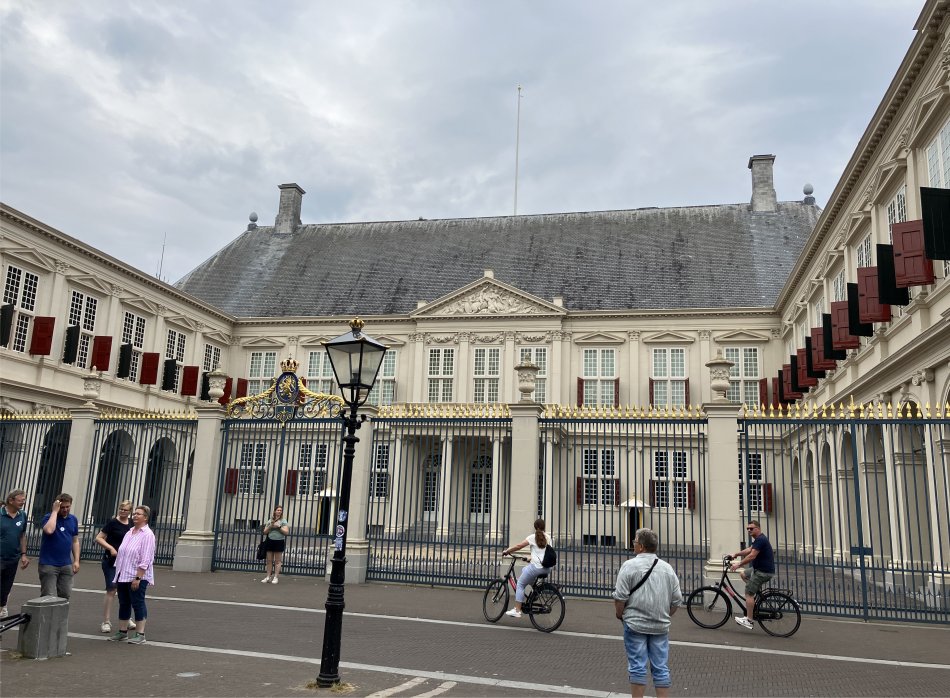 Noordeinde Palace |
Compared to other European palaces, Noordeinde is modest and located at a wonderful location on one of The Hague's shopping streets. The chic Noordeinde district is primarily known for its distinctive fashion boutiques, galleries and art and antiques dealers located in beautiful art nouveau buildings. Jewellers, antique dealers and galleries are interspersed with coffee cafés and restaurants.
On Wednesday mornings, HM King Willem-Alexander regularly welcomes new ambassadors who come to present their letters of credence at Noordeinde Palace. The new ambassador arrives by state coach early in the morning, escorted by horsemen from the Royal Netherlands Mounted Police. After an honorary salute of four drumrolls, the national anthem of the ambassador's country is played, followed by an inspection of the guard. Inside, the King awaits the new ambassador.
We sauntered along the Lange Voorhout, now home to many foreign embassy buildings. I stopped to read the plaque outside the Swiss ambassador's house. A chap was measuring up some pot plants at the top of a flight of steps by the doorway. I soon learned he was the ambassador, and the gardener. He was keen to learn of our trip across the North Sea, the crossing times and our plans for our trip. He wished us well.
At the end of Lange Voorhout, we conveniently arrived at the 18th-century Lange Voorhout Palace, once home to members of the Dutch royal family, and now housed a collection of the work of Dutch graphic artist Maurits Cornelis Escher (1898-1972). The permanent exhibition features notes, letters, photos and plenty of woodcuts and lithographs from various points of his career, including everything from the early realism to the later phantasmagoria. All are fascinating exercises in the blending of different perspectives, and the conjunction of mathematical rules and artistic subject matter.
I found the life of Escher as fascinating as his works of art. He was born in Leeuwarden as the fourth and youngest son. After five years the family moved to Arnhem, where he spent most of his youth. After he failed his final exam, and after a short interlude in Delft, M.C. Escher started with his lessons in architecture at the School of Architecture and Decorative Arts in Haarlem. Already after a week, he informed his father that he wanted to quit his architecture lessons and focus on studying graphic arts. He was supported in this by his teacher Samuel Jesserun de Mesquita, to whom he had shown his drawings and linocuts.
After completing his school, he travelled for a long time through Italy, where he met his wife Jetta Umiker and whom he married in 1924. They went to Rome, where they lived until 1935. During these 11 years Escher travelled every year through Italy where he made drawings and sketches that he later used in his studio for his lithographs, woodcuts and wood engravings.
For example, the background in the lithograph Waterfall (1961) came from his Italian period. The trees that are reflected in the woodcut Puddle (1952) are also the same trees that he used in his woodcut Pineta by Calvi, made in 1932.
During the time that he lived and worked in Italy, he made beautiful, also more realistic works such as the Castrovalva litho in which one can see already his fascination for perspective: close, far, high and low. Likewise, is the lithograph Atrani, a small town on the Amalfi coast in Italy, which he made in 1931 and comes back in his masterpieces Metamorphosis I and II.
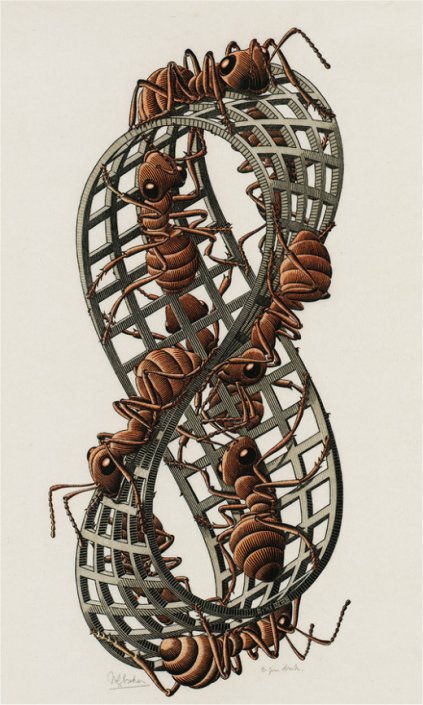 Mobius Strip II |
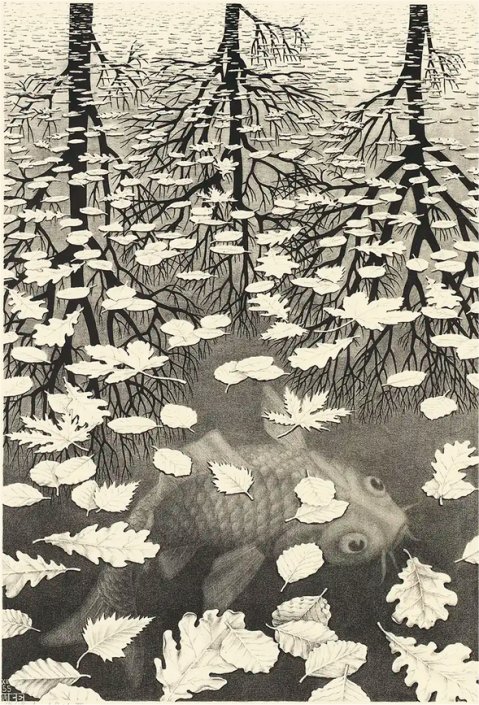 Three Worlds |
Escher will forever be linked with his teacher and close friend Samuel Jessurun de Mesquita. de Mesquita is known as the man who discovered Maurits Cornelis Escher. The talented artist and printmaker also taught graphic techniques at the School of Architecture and Decorative Arts. When Escher enrolled there as an architecture student, De Mesquita happened to see some of his graphic work. He was so impressed that he persuaded Escher to switch courses. Escher went on to become a master of printmaking, and the two developed a lifelong artistic and personal connection. Their artistic preferences partially coincided, but De Mesquita had his own very distinctive style, reducing his images of people and animals to the essence, and rendering his subjects in just a few powerful lines. In other images his style is less restrained. These imagined scenes are often humorous, though some are ominous. After De Mesquita’s death in Auschwitz in 1944, Escher continued to honour the memory of his teacher and friend. In this exhibition Samuel Jessurun de Mesquita’s poignant prints were shown alongside those of his most famous student.
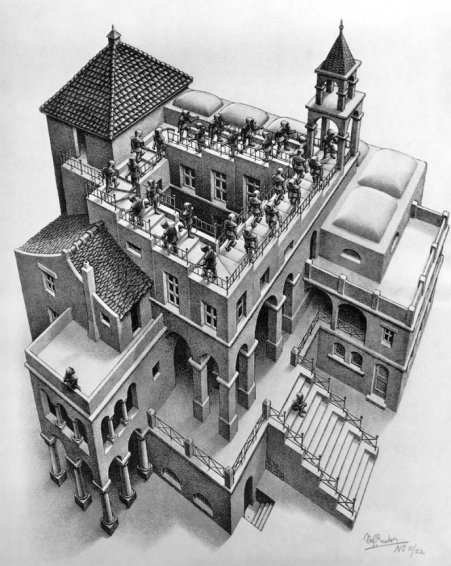 Ascending and Descending |
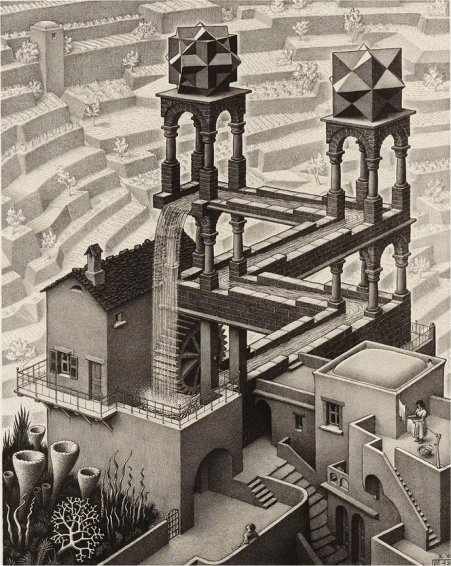 Waterfall |
During his lifetime, Escher made 448 lithographs, woodcuts and wood engravings and more than 2000 drawings and sketches. Just like some of his famous predecessors - Michelangelo, Leonardo da Vinci, Dürer and Holbein - Escher is left-handed. In addition to his work as a graphic artist, he illustrated books, designed carpets and banknotes, stamps, murals, intarsia panels etc.
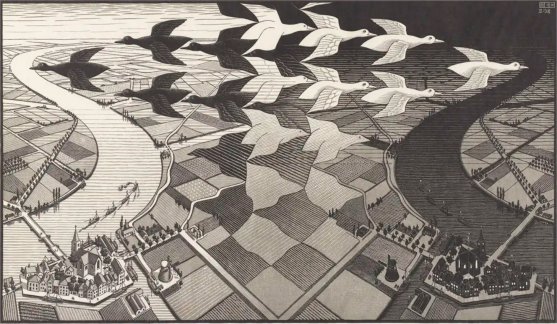 Day and Night |
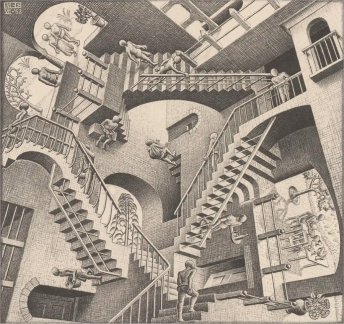 Relativity |
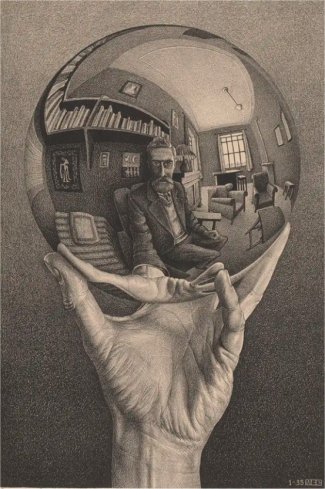 Hand with Reflecting Sphere |
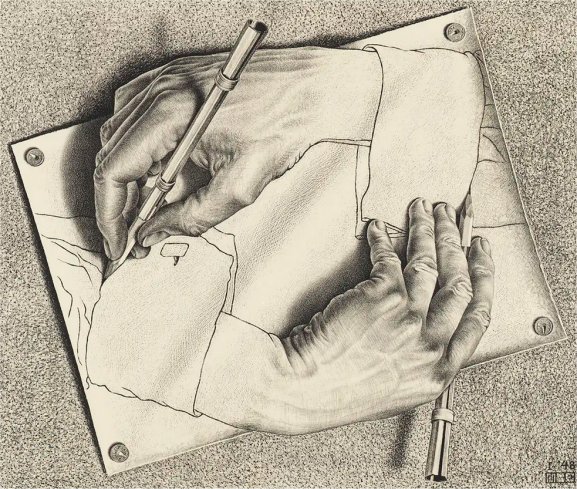 Drawing Hands |
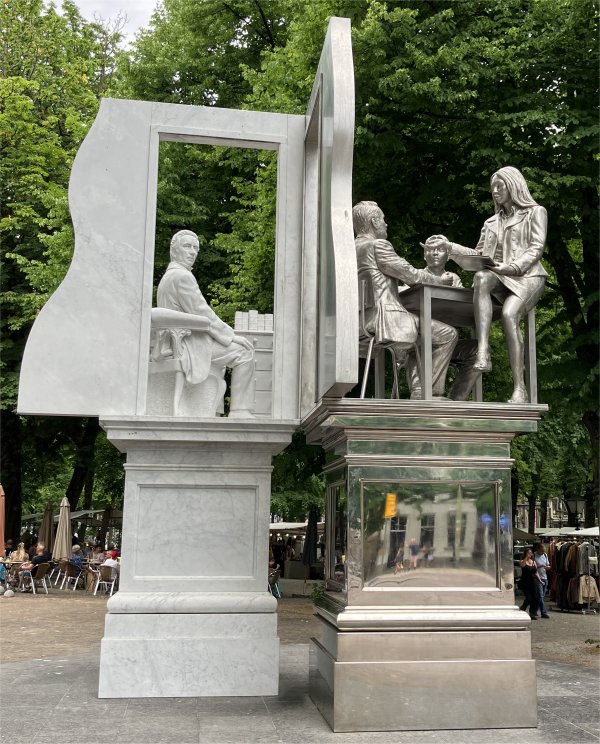 Thorbecke Monument |
During his years in Switzerland and throughout the Second World War, he worked with great energy on his hobby. He then made 62 of the 137 symmetrical drawings he would make in his life. He also expanded his hobby by using these symmetrical drawings for cutting wooden balls.
He played with architecture, perspective and impossible spaces. His art continues to amaze and wonder millions of people around the world. In his work we recognize his excellent observation of the world around us and the expression of his own fantasy. M.C. Escher shows us that reality is wonderful, understandable and fascinating.
That trip to the Lange Voorhout Palace certainly gave me my art fix that I craved for on such trips. Our spirits were both elevated by the visit. We headed off past the Biologische Weekmarkt (Organic Weekly Market) full of stalls selling vegetables, and mountains of mushrooms and cheeses. Just on the edge of the market stood a remarkable piece of art on Lange Voorhout, the Thorbecke Monument, symbolising the Dutch democracy. The marble statue represents Thorbecke from the 19th century. The man behind the Dutch constitution. He is seated at his desk, looking out onto the quarters of the Prime Minister from Voorhout. The second part of the statue, made of reflective metal, represents three citizens sitting at and on top of a table. Both parts touch and are connected via two open doors. We continued our hike down by the Hofvijver along the Korte Vijverberg, passing the King's Cabinet and the city's historical museum which had been closed earlier.
We took refresment in 't Plein, then got back to the train station and caught another train down to Delft, a 10-minute journey. On arrival I dashed into the VVV to pick up a walking guide to the city. The chap on the counter helpfully explained that all the churches would be closed to the public since Sunday services would be taking place. Most of the museums, which he pointed out on the map, would be closing at 5pm; we would have time to visit only one. Pink routes highlighted on the map would give us an idea of streets we perhaps might consider to walk down. I thanked the chap and we marched off to explore.
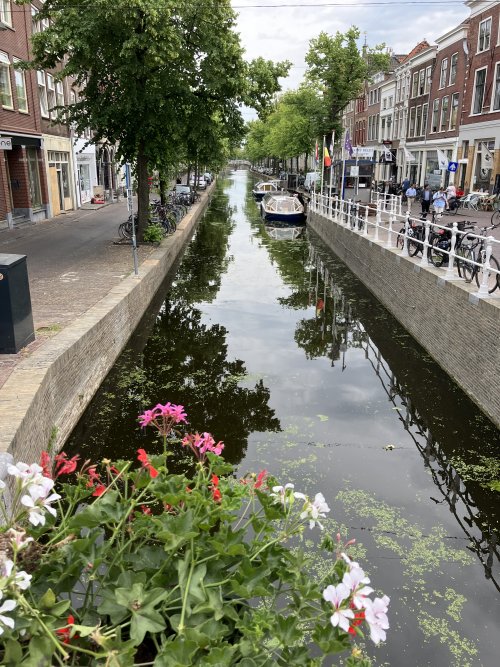 Koornmarkt from Touwbrug |
In addition to its signature blue-and-white Delft Blue pottery, the city was also the birthplace of Johannes Vermeer, a painter from the Dutch Golden Age who was best known for his work depicting women in everyday domestic scenes, most notably the mysterious "Girl with The Pearl Earring".
The western city also plays an important role in the history of the Netherlands. Delft was home to the Dutch Prince, William of Orange. When he died in 1584, the official royal burial town of Breda was under Spanish control. Because of this, he was laid to rest in Delft - a tradition that continues today for the Dutch royal family. Johannes Vermeer also shares the place of his burial, the Nieuwe Kerk.
Delft has a technical university, founded in 1842 as the Royal Academy, and hydraulic laboratories where the Delta Plan was designed for the restriction of the Rhine and Meuse estuaries.
We weaved a path along the Oude Delft and Koornmarkt canal streets, passing increasingly older buildings, and all of a sudden stumbled across the Markt (Market Square), essentially the centre of the old town. It was a pity we weren't here on a Thursday, the market day. The square would then be jammed with at least 150 covered stalls, offering flowers, vegetables, tasty cheeses, hand-crafted souvenirs, fresh bread, antiques, books and jewellery.
But today the square bustled with folk enjoying a Sunday afternoon. Surrounding the square were a variety of shops selling clothing, cheeses, bicycle parts, antiques, electronics, and of course a few outlets for Delft pottery. There were pubs and fresh-air terraces, cafes and restaurants. Shoppers, visitors and locals were all bargaining and tasting
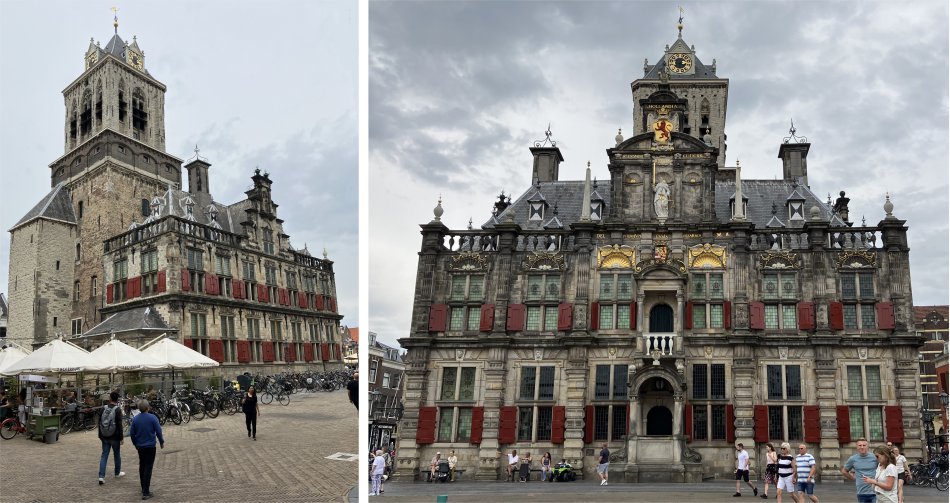 Town Hall |
The western end of the square was dominated by the Town Hall, a Renaissance style building. It is the seat of the city's government as well as a popular venue for civic wedding ceremonies. The Town Hall was originally built around 1200, but was almost completely destroyed by a fire in 1618. Only the tower "Het Steen" (The Stone) survived. The tower was originally built around 1300 and has decorative clockfaces from 1536, and the bells were made by Hendrick van Trier and Francois Hemony. The facade has a "Justitia" statue. "Het Steen" was once used as a prison, and its most notorious prisoner was Balthasar Gerards, the man who assassinated Willem of Orange (Willem the Silent).
The famous architect Hendrik de Keyser designed a new building around the tower, with red shutters, dating back to 1618-20. De Keyser was one of the best architects of his time. In addition to the Town Hall, his architectural achievements also included the ornate tomb of Willem of Orange in the New Church.
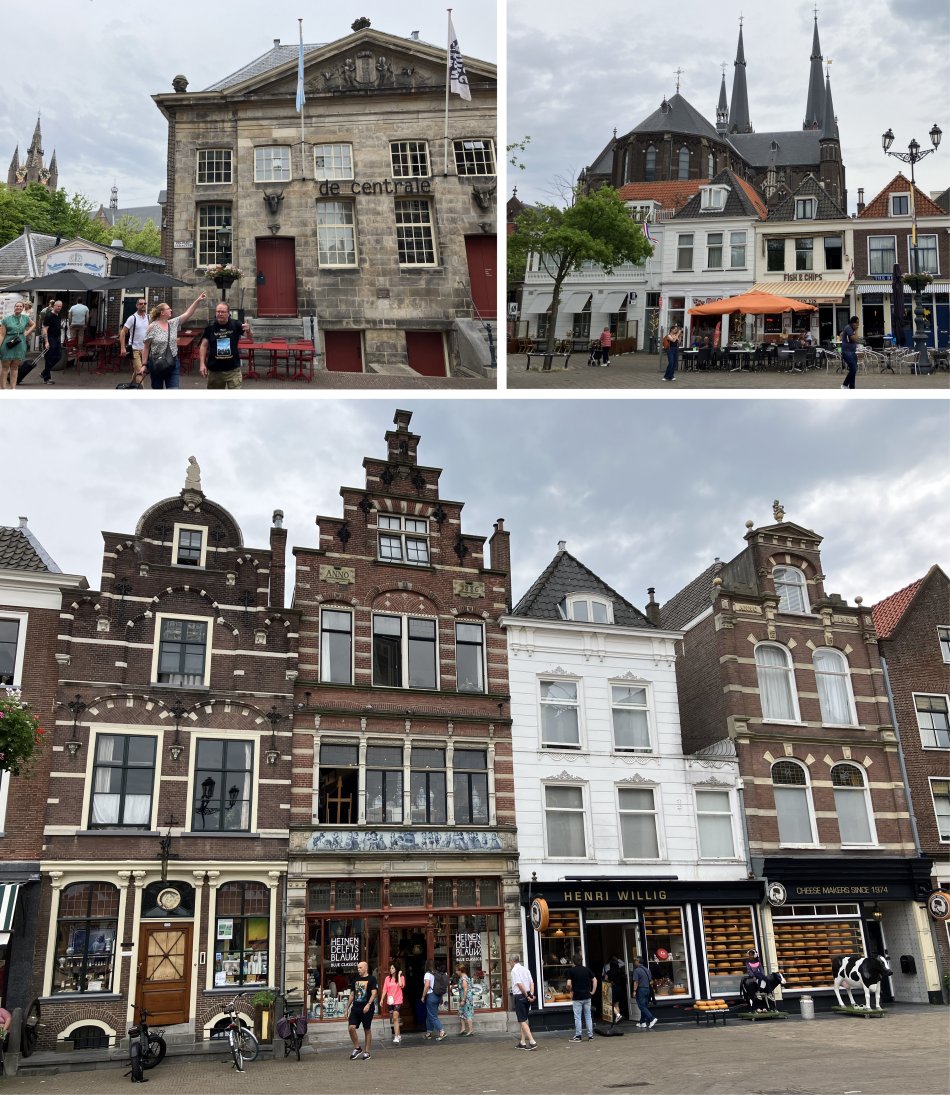 A Stroll around the Markt |
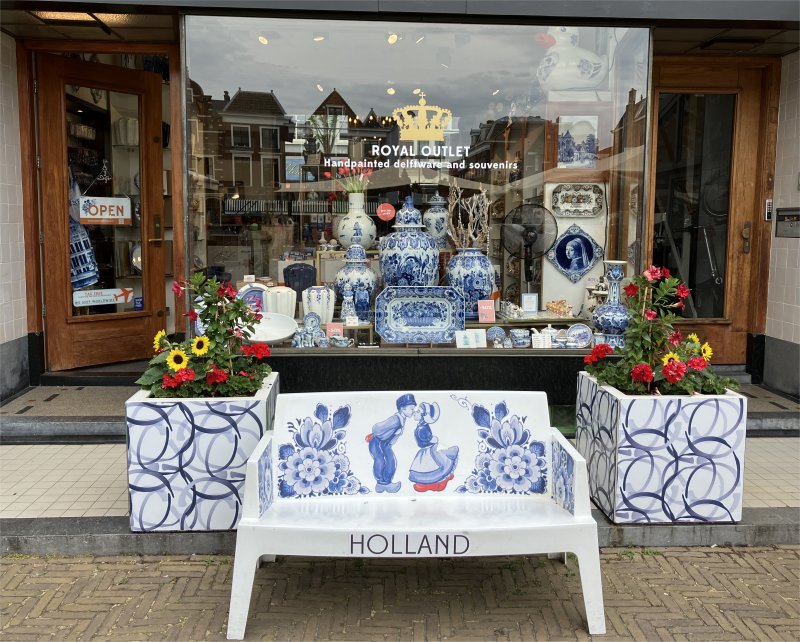 A Typical Delftware Shop |
During the 16th century, artisans in the Low Countries began creating a distinctive style of tin-glazed earthenware that employed vivid shades of blue in order to depict floral motifs, natural landscapes and historical or biblical iconography. This type of pottery was mainly produced around the city of Delft, it was eventually given the title Delftware, or alternatively Delft Blauw.
Historically speaking, Delftware actually originated in Antwerp around 1500, when an Italian potter named Guido da Savino started producing similar ceramic artwork according to methods that would eventually be associated with the city of Delft. Due to ongoing conflicts in this part of Europe, many craftspeople working in Antwerp decided to move north into the Netherlands, and settled in several Dutch cities including Rotterdam, Gouda and Amsterdam.
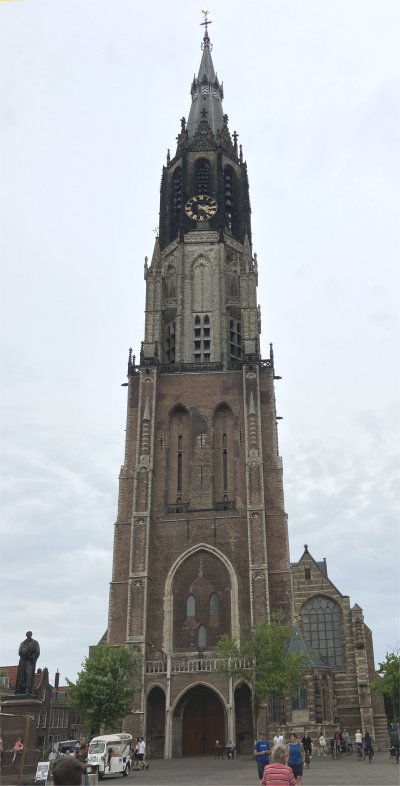 Nieuwe Kerk |
These foreign ceramics were prized among Dutch potters and many began imitating their Asian counterparts' techniques. Eventually, the Netherlands overtook China and Japan's joint monopoly on earthenware and flooded the international market with Delftware pottery. Historians believe that Delft potters created over 800 million tiles between the 16th and 18th century and, because of this massive number, many Dutch homes are still fitted with authentic Delftware tiles that originated during this period. Today, Delftware is still produced in the Netherlands, but is mainly created by certified factories located in the Dutch province of Friesland. Sadly, we did not have sufficient time to visit the Delft Pottery Museum.
Standing high and proud at the eastern end of the square towered the Protestant Nieuwe Kerk (New Church). The first Nieuwe Kerk was a temporary wooden church, constructed from 1381-1382 and consecrated on July 6th, 1382. The building of a basilica finally started in 1396. It was built around the wooden church which remained until 1420. Exactly 100 years later, in 1496, the tower was finally ready. The church was dedicated to the Virgin Mary (the patron from the former wooden church) and to Saint Ursula.
The tower was struck on 3rd May 1536 by heavy lightning which, fanned by a strong wind, led to the subsequent fire which devastated a great part of Delft. The iconoclasts of 1566 left their horrible marks as well. In 1572 the building was taken over by the Reformed Church. The Delft powder magazine explosion on 12th October 1654 destroyed the roof and the newly made stained-glass windows, but the church could already be used again by spring 1655. In 1872 more heavy lightning destroyed the tower again. It was rebuilt in 1875 (designed by Petrus J. H. Cuypers who in 1885 also designed the present building of the Rijksmuseum Amsterdam) to its present height of nearly 109 meters, only surpassed in the Netherlands by the Dom tower in Utrecht.
When Willem of Orange (Willem the Silent), father and first stadtholder of the young Dutch Republic, was assassinated in 1584, it was customary to bury members of the Nassau-family in Breda. However, at that time Breda was in the hands of the Spanish, so that Willem I had to be buried in Delft, in the Nieuwe Kerk. The church remains the final resting place of nearly all members of the house of Orange-Nassau including all Dutch monarchs. The magnificent monument for William I, created by Hendrick de Keyser and his son Pieter 1614-1623, is still the object of honour and admiration of thousands of visitors each year.
Near the New Church is the statue of Hugo Grotius, humanist, jurist, poet and playwright of the 16th and 17th centuries.
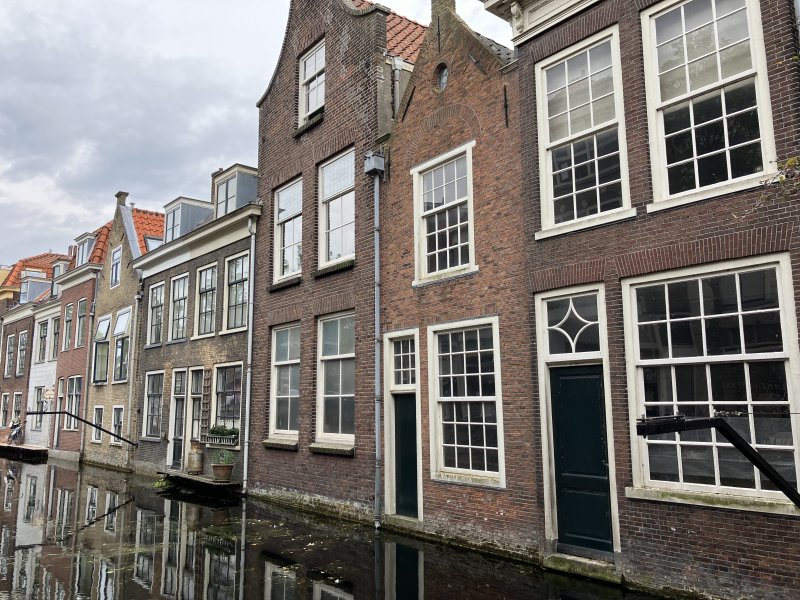 Voldersgracht, One of the Oldest Canals in Delft |
Having viewed the outside of the Nieuwe Kerk (being Sunday we were not allowed inside), we were ready to discover the Oude Kerk. The pink route on our walking guide took us down the Voldersgracht, one of the oldest canals in the city of Delft. It dates from at least 1348. The Voldersgracht has the special feature that it is half a canal with a street on one side and houses on the water on the other. It owes its name to the cloth fullers who practiced their profession there in the Middle Ages. They used the moat to flush out their waste products: a mixture of urine, fuller's earth and dirt from the fulled sheets.
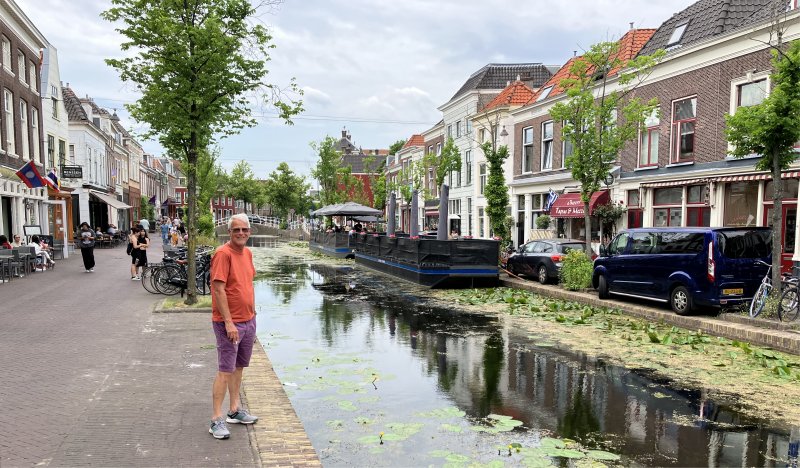 A Poser on the Vrouwjuttenland |
At the end, a left turn took us down Vrouwjuttenland, another canal for Rex to pose by, then we turned left again onto Choorstraat, a street full of shops. This conveniently brought us to the Oude Kerk (Old Church).
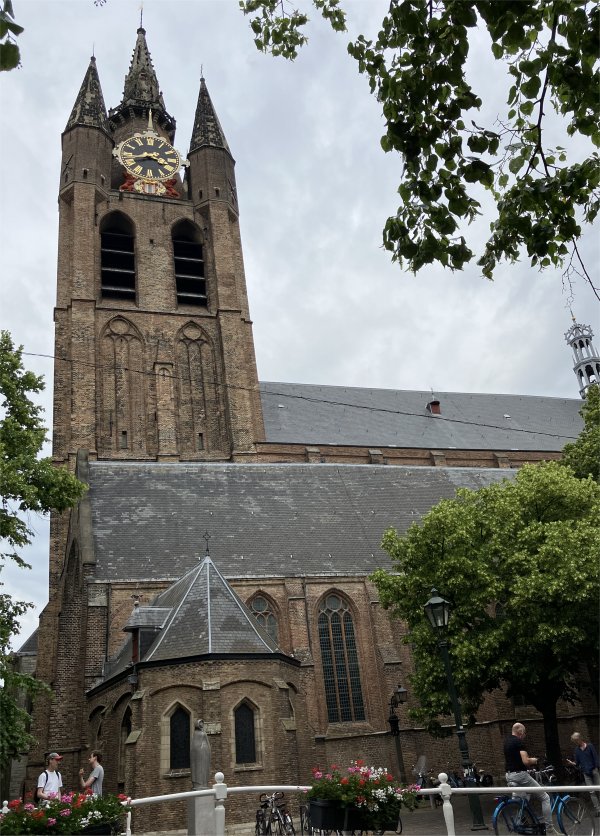 Oude Kerk |
The Oude Kerk, nicknamed Oude Jan (Old John) and Scheve Jan (Skewed John), is a Gothic Protestant church in the old city centre. Its most recognizable feature is a 75m-high brick tower that leans about two meters from the vertical. The Oude Kerk was founded as St, Bartholomew's Church in the year 1246, on the site of previous churches dating back up to two centuries earlier. The layout followed that of a traditional basilica, with a nave flanked by two smaller aisles.
The tower with its central spire and four corner turrets was added between 1325-50, and dominated the townscape for a century and a half until it was surpassed in height by the Nieuwe Kerk. During its construction the foundations were not strong enough to support the building, and the church began to lean. As work continued, the builders tried to compensate for its lean on each layer of the tower, but to this day only the four turrets at the top are truly vertical. It is possible that the course of the adjacent canal had to be shifted slightly to make room for the tower, leaving an unstable foundation that caused the tilt.
By the end of the 14th century, expansion of the side aisles to the height of the nave transformed the building into a hall church, which was rededicated to St. Hippolytus. The church again took on a typical basilican cross-section with the construction of a higher nave between about 1425 and 1440.
The Delft town fire of 1536 and the turmoil of the Protestant Reformation brought a premature end to an ambitious expansion project led by two members of the Keldermans family of master builders. This construction phase resulted in the flat-roofed, stone-walled northern transept arm that differs markedly in style from the older parts.
The great fire, iconoclasm, weather, and the explosion of the town's gunpowder store in 1654 took their toll on the church and its furnishings, necessitating much repair work over the years. During one renovation, the tower turrets were rebuilt in a more vertical alignment than the leaning body below, giving the tower as a whole a slightly kinked appearance. The current stained-glass windows were crafted by the master glazier Joep Nicolas in the mid-20th century.
On 15th December 1675 Johannes Vermeer was buried in Oude Kerk, in a family crypt in the northern transept, bought by his mother-in-law Maria Thins in 1661. But when he died there was no money for a tombstone. Today his burial place has two grave markers: a rather austere one from 1975 to commemorate the 300th anniversary of his death, located at about the same place as the former family grave, and a new larger, discreetly decorated one near the western side entrance placed 26th January 2007.
Continuing on our ruthless tracking of the pink route on our guide, we headed down Oude Delft and stumbled across a Gemeenlandshuis, or Waterschapshuis, a building that is (or was formerly used as) the headquarters of one of the Waterboards of the Netherlands.
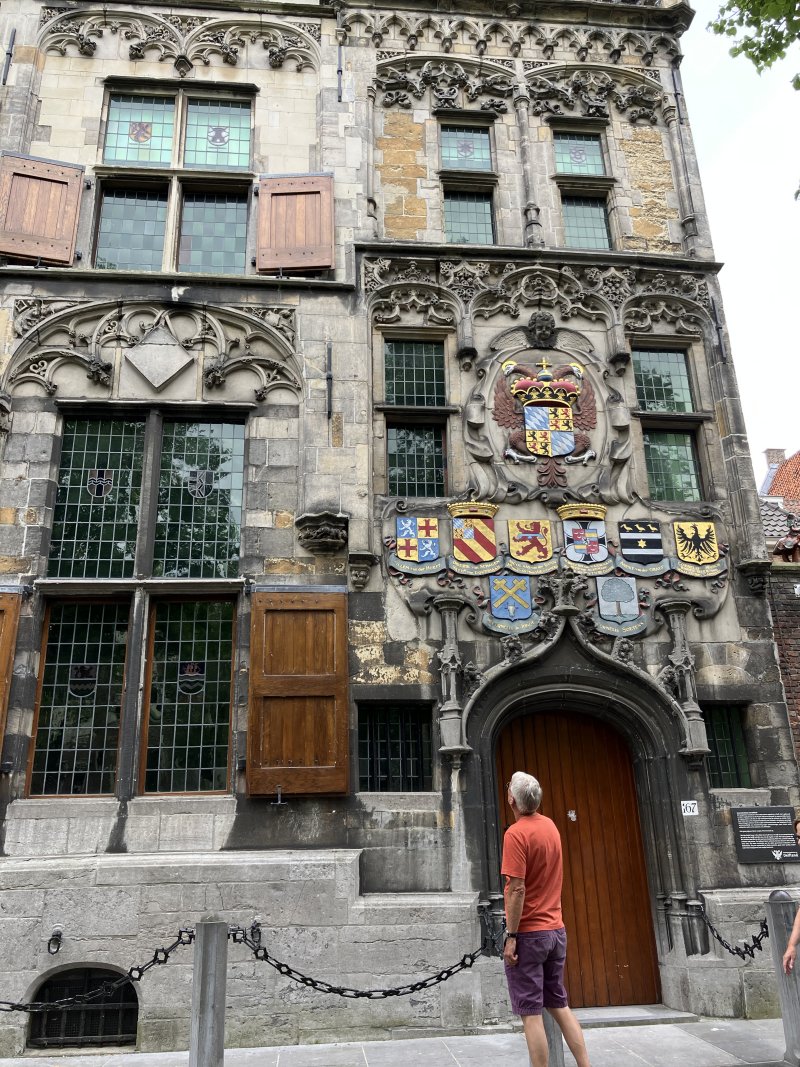 Hoogheemraadschap van Delfland |
The Water Boards became governing bodies much like a town hall became a meeting place for the city council. In most Dutch cities, especially those on a river or located at a seaside port, the Gemeenlandshuis was the same size as the Town Hall. Examples can be seen today in Leiden, home to the Gemeenlandshuis van Rijnland, and Delft, home to the Hoogheemraadschap van Delfland.
The Gemeenlandshuis in Delft houses the main office of the Delfland Water Board. The Late-Gothic building, situated on the Oude Delft 167, was built in 1505. The first owner was Jan de Huyter, bailiff of Delft and steward of Delfland. Later occupants were Philips, Count of Hohenlohe who was married to Maria of Nassau, a daughter of Willem of Orange. The Delfland Water Board has been established here since 1645. A large number of Coats of Arms (or heraldic shields) cover the sandstone façade. Fortunately, the façade was spared during the fire of 1536 which burned through the city of Delft.
Still sticking the pink route, we followed it to Buitensplein, only to discover this was primarily a shopping district with theatres and cinemas. It was time to call it a day, and we caught a train back to Amsterdam; standing room only till Leiden!
On reaching Amsterdam Centraal, Rex wanted to go back to the boat. "I need to get some more of my cigarettes," was his reason. "What, go all the way back there to pick up another few packets of coffin nails," was my response, "and then come all the way back here. You must be joking. Try and do without the ciggies for a change." Not very sympathetic I know, but I hate to see a mate slowly killing himself.
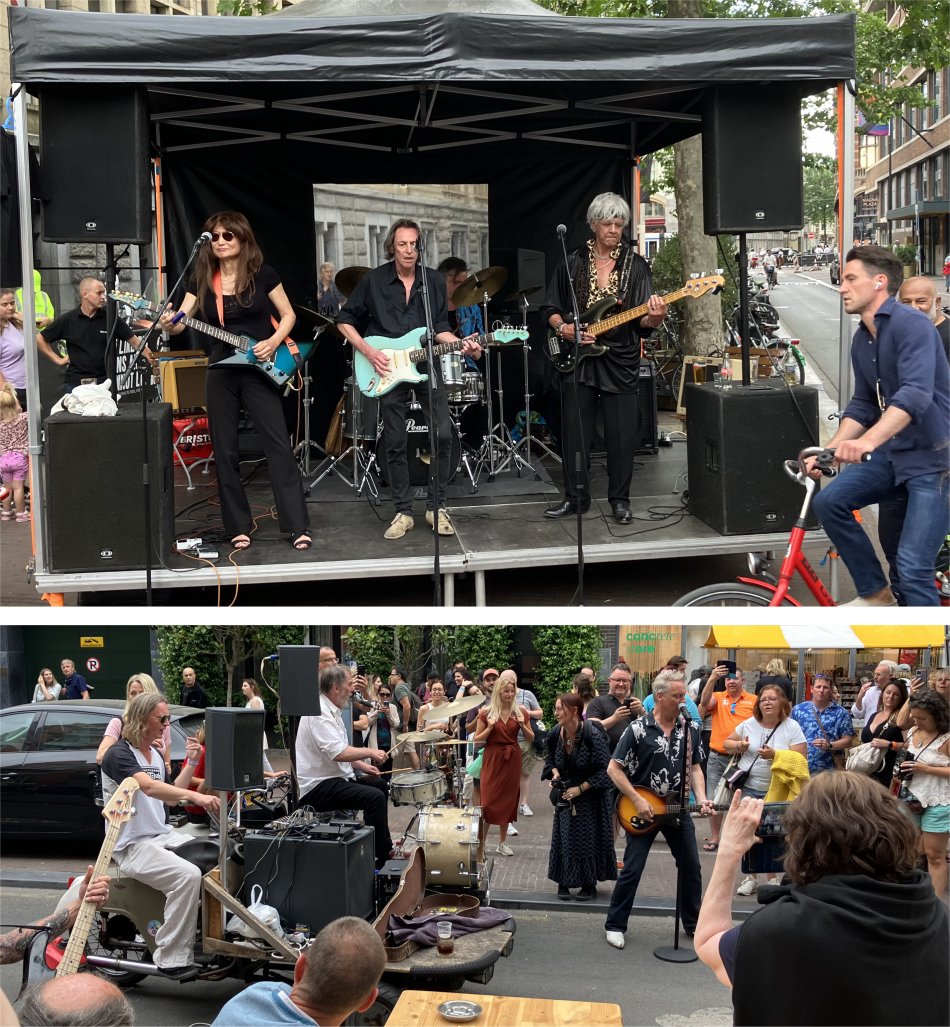 Bands Playing in Spuistraat |
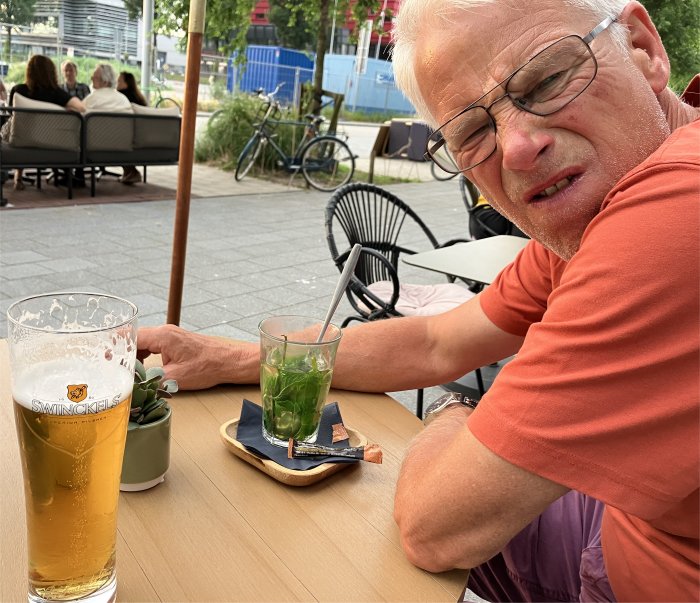 Rex Enjoying Mint Tea |
But our stomachs were pressing us to seek out food. Rex thought we should head down a side street, but I soon cottoned on his ulterior motive, but after a detour we located a lovely little Thai restaurant and dined well.
Once back at the marina, we visited Fred's Bar, a place we had never visited before. A nightcap was the order of the evening, me settling for a beer, Rex, being a health freak, opted for mint tea!
